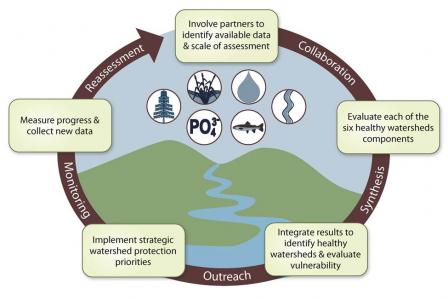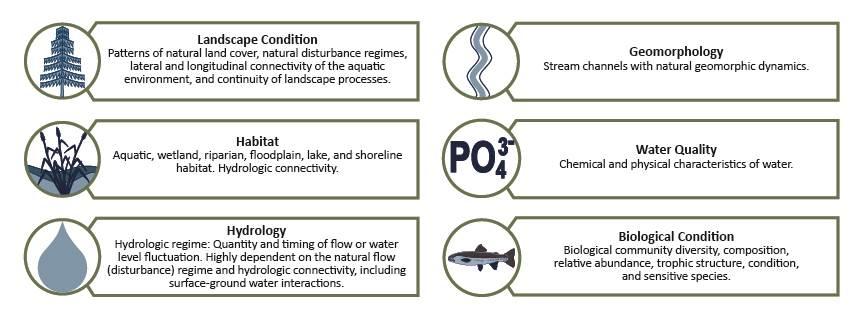Integrated Assessment of Healthy Watersheds
On this page:
Overview
The Healthy Watersheds Program conceptual framework views watersheds as integrated systems that can be understood through assessments, which capture the interacting dynamics of their essential ecological attributes. Since watersheds are not static systems, healthy watersheds assessments should incorporate expected future changes, including land and water use changes, and should take into account vulnerability to climate change and population growth.
For more information on identifying healthy watersheds, see Identifying and Protecting Healthy Watersheds: Concepts, Assessments, and Management Approaches.

Developing a Watershed Health Index
The foundation of a healthy watersheds assessment is compilation of ecological information that is measurable, comparable and consistent across the area of the assessment, and relevant to summarizing the primary attributes of a watershed’s condition. Watershed indicators are first selected, based on the six essential ecological attributes fundamental to the healthy watersheds assessment approach. These attributes are discussed below.
A sub-index for each of the six attributes is developed from these indicators. Sub-index values for each watershed are then aggregated up into a single Watershed Health Index value for each watershed.
All sub-index and index values are relative (i.e., "healthier" vs. "not as healthy"), not absolute (i.e., no "healthy vs. unhealthy" cutoff score is identified) and thus are meant for comparing relative differences among watersheds rather than precisely defining healthy vs. unhealthy watersheds.
Attributes of Watershed Health
 Six types of subindices that combine to make up the watershed health indexMultimetric indices or other methods may be used to integrate multiple indicators representing different healthy watersheds attributes. Healthy watersheds integrated assessments can range from screening-level assessments using GIS data layers, to statistical and geospatial modeling of ecological attributes.
Six types of subindices that combine to make up the watershed health indexMultimetric indices or other methods may be used to integrate multiple indicators representing different healthy watersheds attributes. Healthy watersheds integrated assessments can range from screening-level assessments using GIS data layers, to statistical and geospatial modeling of ecological attributes.
See examples of integrated assessments.
Healthy Watersheds integrated assessments are based on an assessment of:
Landscape Condition
Landscape condition assessments examine the condition and configuration of natural land cover in the landscape. Natural vegetative cover stabilizes soil, regulates watershed hydrology and provides habitat to terrestrial and riparian species. The type, quantity, and structure of the natural vegetation within a watershed have important influences on aquatic habitats. Natural land cover provides connectivity among riparian habitats and between terrestrial and aquatic ecosystems.
Many aquatic organisms depend on being able to move through connected systems to habitats in response to variable environmental conditions. Forested riparian zones are often some of the best remaining corridors for connecting habitat patches on the landscape. Vegetated landscapes cycle nutrients, retain sediments, and regulate surface and ground water hydrology. Natural disturbances on the landscape, such as fire, help to regulate nutrient and organic matter input to aquatic ecosystems.
See more information about landscape condition assessments and examples of these assessments on the Examples of Landscape Condition Assessments for Watershed Health page.
Habitat Condition
Freshwater habitats are comprised of flowing (i.e., streams and rivers) and standing (i.e., lakes, ponds, and wetlands) waters. Habitat extent and quality are directly related to landscape condition and hydrologic and geomorphic processes. Habitat quality is also affected by the physical and chemical characteristics of the water (e.g., water temperature). The number and distribution of different habitat types and their connectivity influence species population health.
See examples of habitat assessments on the Examples of Habitat Condition Assessments for Watershed Health page.
Hydrology
Watershed hydrology is driven by climatic processes; surface and subsurface characteristics such as topography, vegetation, and geology and human activities such as water and land use. Aquatic ecosystems are dependent on surface and/or ground water hydrology. For example, groundwater-dependent ecosystems rely on water that infiltrates to the subsurface discharging to nearby streams or recharging to an aquifer and then discharging to springs, seeps, wetlands, streams, and lakes.
Hydrologic regimes (flows in rivers and water levels in lakes and wetlands) create habitat and are important to aquatic species life histories (e.g., providing cues for spawning and migration during discrete times of the year). Natural flow regimes are composed of seasonally varying environmental flow components, including high flows, base flows, pulses and floods that can be characterized in terms of their magnitude, frequency, duration, timing and rate of change. Natural lake levels will vary depending on precipitation, evaporation and/or ground and surface water hydrology.
See examples of hydrology assessments on the Examples of Hydrology Assessments for Watershed Health page.
Geomorphology
Watershed inputs (water, sediment and organic matter) and valley characteristics (valley slope and width, bedrock and surficial geology, soils and vegetation) determine a river channel’s form (pattern, profile and dimension). Although watershed inputs and channel form vary over time, they are balanced in natural systems. This natural balance is termed “dynamic equilibrium” and refers to sediment size and volume being in balance with stream slope and discharge.
Any time one of these variables changes, the other variables will respond to bring the stream back to a dynamic equilibrium. Disturbances such as floods or forest fires are natural, episodic events that cause a stream to become unbalanced. After such disturbances, the stream will “seek” equilibrium conditions through adjustment of the other components until the stream is once again in a form that allows it to efficiently perform its functions of water and sediment discharge.
These periodic disturbances, of natural intensity and frequency, can increase aquatic biodiversity by creating opportunities for some species and scaling back the prevalence of others. When disturbances are of extreme intensity or frequency, as many human disturbances are, a stream channel will undergo adjustment to a new form. This can result in habitat degradation and threats to public safety and infrastructure.
See examples of hydrology assessments on the Examples of Geomorphology Assessments for Watershed Health page.
Water Quality
- concentrations of organic and inorganic constituents, such as nutrients, trace metals and dissolved organic matter;
- additional chemical parameters indicative of habitat suitability, such as pH and dissolved oxygen; and
- physical parameters, including water temperature and turbidity.
Many of these parameters are dynamic and related to natural watershed processes. For example, dissolved oxygen fluctuations in streams are related to nutrient cycling, biotic activity, stream flow and temperature.
See examples of water quality assessments on the Examples of Water Quality Assessments for Watershed Health page.
Biological Condition
Freshwater aquatic biodiversity refers to the richness of native species (e.g., fish, invertebrates and plants), genetic variety, and multiple habitats and ecosystems types (e.g., lakes, ponds, and reservoirs, rivers and streams, groundwater and wetlands). The biological condition of an aquatic ecosystem is often thought of as the ultimate indicator of watershed health, as aquatic organisms and communities reflect the cumulative conditions of all other watershed components.
Biological condition is measured in a variety of ways. For example, multimetric indices measure the presence, numbers and condition of aquatic organisms and communities in an aquatic ecosystem. They are intended to represent the biological condition of an aquatic ecosystem relative to some regionally-defined reference condition. RIVPACS (River Invertebrate Prediction and Classification System) models quantify biological condition by comparing the observed (O) taxa at a site to expected (E) taxa in the absence of human-caused stress. The O/E ratio is the index of biological integrity and measures loss of native taxa or biodiversity. Biodiversity is also measured by presence of rare, threatened and endangered (RTE) species. State natural heritage programs have inventories of aquatic RTE.
See examples of biological condition assessments on the Examples of Biological Condition Assessments for Watershed Health page.
Attributes of Vulnerability
Watershed condition changes over time due to natural processes and anthropogenic influences. The most pervasive changes to watershed condition will come from population increase (changes in land and water use) and climate change. Watershed vulnerability can be defined as a combination of a system’s exposure, sensitivity and adaptive capacity to cope with changes in population and climate. For example, with the availability of downscaled general circulation models (GCMs), the relative exposure to future projected changes in temperature and precipitation can be evaluated for watersheds across a large region or state.
While projected climate change provides information on relative exposure to stress for watersheds across a state, the sensitivity of those watersheds to such changes is generally unknown. However, many efforts around the nation are underway to model the expected hydrologic response of the landscape to future changes in climate (e.g., changes in baseflow, surface runoff and snowpack). Finally, the adaptive capacity of a watershed to cope with such changes is enhanced by connectivity of habitats and maintenance of floodplain, wetland, and other landscape features in their natural conditions to support natural hydrology and sediment supply.
See more information about vulnerability assessments and examples of these assessments on the Developing a Watershed Vulnerability Index page.
